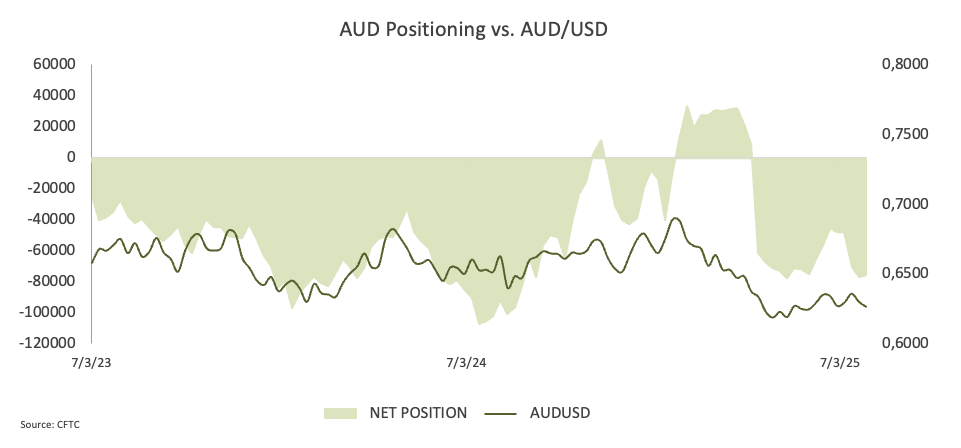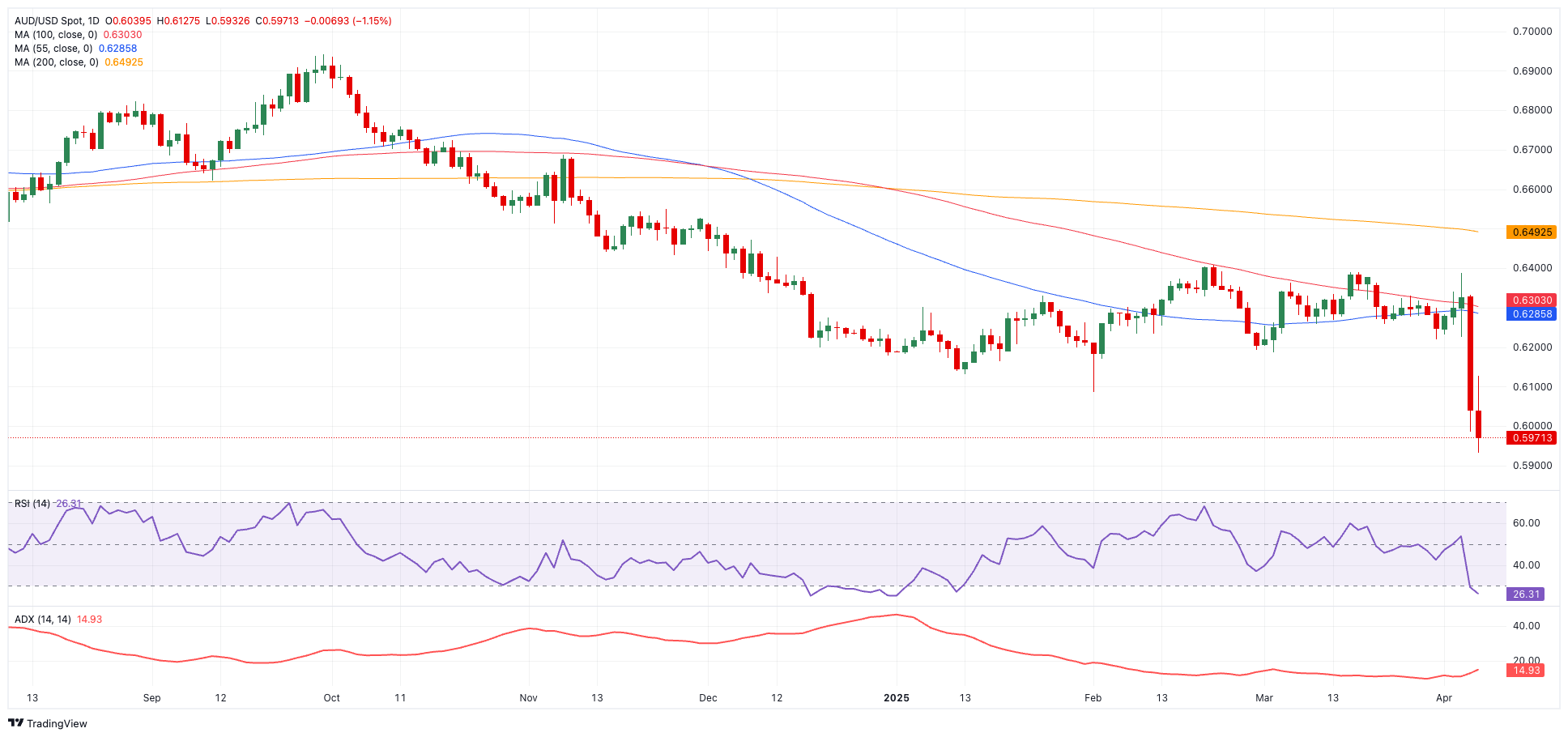- AUD/USD plummeted to multi-year lows in the sub-0.6000 zone.
- The US Dollar advanced marginally following Friday’s sharp bounce.
- Stock markets worldwide tumbled as they assessed Trump’s tariffs
The Australian Dollar (AUD) managed to regain a small smile on Monday following Friday’s striking decline following news of Chinese retaliation to tariffs announced by President Trump’s “Liberation Day”.
That said. AUD/USD extended that drop to levels last seen in March 2020 around 0.5930 earlier on Monday, although it recouped part of that move and regained the 0.6000 barrier and beyond as the day progressed.
Rising global trade war fears
Trade tensions are ratcheting up fast. President Trump’s newly imposed tariffs—ranging from 10% to 50% on multiple trading partners—have already provoked sp,e retaliatory measures and fanned the flames of a full-blown global trade war.
Such an escalation would threaten economic activity, consumer prices, and central bank policies around the globe. Given Australia’s close ties to China and its commodity exports, the Aussie remains especially sensitive to any slowdown in Chinese demand or broader fallout from US tariffs.
Indeed, that tension came to a head when China unveiled its own set of tariffs in the latter part of last week, sending AUD/USD into a nosedive. In addition, robust US jobs data (+228K) and hawkish commentary from Fed Chair Jerome Powell only added to the downward pressure. That steep pullback in just 24 hours underscores the extreme volatility the Aussie faces amid intensifying trade disputes and domestic economic headwinds.
The delicate balance of the Fed
Across the Pacific, the Federal Reserve (Fed) faces a delicate balancing act. Escalating trade conflicts could stoke inflation, justifying further rate hikes. At the same time, signs of a cooling US economy argue for caution—despite a still-solid labour market. In its March 19 meeting, the Fed held rates steady at 4.25–4.50% and reiterated a “wait-and-see” approach. Chair Jerome Powell highlighted forecasts for slower growth and slightly higher inflation, both of which could be exacerbated by looming tariffs.
On Friday, Chief Powell argued that, while uncertainty remained elevated, it was becoming evident that the tariff increases would be significantly larger than expected. He further mentioned that the economic effects were likely to mirror this trend, including higher inflation and slower growth.
RBA Holds Steady Amid Uncertainty
Meanwhile, the Reserve Bank of Australia (RBA) kept its Official Cash Rate (OCR) at 4.10% on Tuesday, as expected. In a notable shift, policymakers dropped their previous caution about “further policy easing” and instead emphasized risks on both sides of the economic outlook. RBA Governor Michele Bullock acknowledged uncertainty over how quickly inflation will return to the 2–3% target range and revealed that the decision to hold rates was unanimous. Following the meeting, markets trimmed the odds of a 25-basis-point cut at the May 20 meeting to 70%, down from 80%.
Bears Bet on the Aussie
According to the latest CFTC report, non-commercial players remained bearish on the Aussie. Despite net shorts shrinking slightly to around 76K contracts in the week ending April 1, the readings remain near the upper end of the range, as they have been steadily rising since mid-December, reflecting growing tariff concerns.

Technical signals for AUD/USD
Risks of extra weakness are expected to remain well in place as long as AUD/USD navigates the area below its key 200-day SMA around 0.6500.
Extra bouts of selling pressure could prompt the pair to retest its 2025 bottom of 0.5930 (April 7), ahead of the 2020 trough at 0.5506 (March 19).
On the upside, if spot can definitively break above the 2025 high at 0.6408 (February 21), the path may open toward the 200-day SMA at 0.6496, with the November 2024 top of 0.6687 as the next key hurdle.
Although the Relative Strength Index (RSI) bouncing towards the 37 level shows some recovery, an Average Directional Index (ADX) near 15 signals that the broader trend remains relatively weak, although off recent lows.
AUD/USD daily chart

What’s next for AUD?
Next on tap in Oz will come the Consumer Confidence gauge tracked by Westpac and the NAB’s Business Confidence reading, all on April 8. Later in the week will come Building Permits and Private House Approvals on April 9, while the Melbourne Institute will release its Inflation Expectations on April 10.
Bottom Line
The Australian Dollar’s immediate direction will hinge on how trade tensions evolve, China’s economic performance, and the careful policy moves of central banks on both sides of the Pacific.
Information on these pages contains forward-looking statements that involve risks and uncertainties. Markets and instruments profiled on this page are for informational purposes only and should not in any way come across as a recommendation to buy or sell in these assets. You should do your own thorough research before making any investment decisions. FXStreet does not in any way guarantee that this information is free from mistakes, errors, or material misstatements. It also does not guarantee that this information is of a timely nature. Investing in Open Markets involves a great deal of risk, including the loss of all or a portion of your investment, as well as emotional distress. All risks, losses and costs associated with investing, including total loss of principal, are your responsibility. The views and opinions expressed in this article are those of the authors and do not necessarily reflect the official policy or position of FXStreet nor its advertisers. The author will not be held responsible for information that is found at the end of links posted on this page.
If not otherwise explicitly mentioned in the body of the article, at the time of writing, the author has no position in any stock mentioned in this article and no business relationship with any company mentioned. The author has not received compensation for writing this article, other than from FXStreet.
FXStreet and the author do not provide personalized recommendations. The author makes no representations as to the accuracy, completeness, or suitability of this information. FXStreet and the author will not be liable for any errors, omissions or any losses, injuries or damages arising from this information and its display or use. Errors and omissions excepted.
The author and FXStreet are not registered investment advisors and nothing in this article is intended to be investment advice.
Recommended Content
Editors’ Picks

EUR/USD extends slide below 1.1350 on renewed USD strength
EUR/USD extends its daily slide and trades below 1.1350 in the American session on Friday. Renewed US Dollar strength on growing optimism about a de-escalation of the US-China trade war makes it difficult for the pair to hold its ground heading into the weekend.

GBP/USD consolidates losses near 1.3300 after UK Retail Sales data
GBP/USD remains under moderate selling pressure near 1.3300 despite the upbeat UK Retail Sales data for March. The pair feels the heat of the solid US Dollar rebound, aided by latest headlines hinting at a softening rhetoric in the ongoing US-China trade conflict.

Gold drops toward $3,250 as market mood improves
Gold turns south following Thursday's rebound and declines toward $3,250 on Friday. The bearish pressure builds up as market mood improves on growing optimism about a de-escalation of the US-China trade conflict after US President Trump hinted at the beginning of negotiations.

Ethereum: Accumulation addresses grab 1.11 million ETH as bullish momentum rises
Ethereum saw a 1% decline on Friday as sellers dominated exchange activity in the past 24 hours. Despite the recent selling, increased inflows into accumulation addresses and declining net taker volume show a gradual return of bullish momentum.

Five fundamentals for the week: Traders confront the trade war, important surveys, key Fed speech Premium
Will the US strike a trade deal with Japan? That would be positive progress. However, recent developments are not that positive, and there's only one certainty: headlines will dominate markets. Fresh US economic data is also of interest.

The Best brokers to trade EUR/USD
SPONSORED Discover the top brokers for trading EUR/USD in 2025. Our list features brokers with competitive spreads, fast execution, and powerful platforms. Whether you're a beginner or an expert, find the right partner to navigate the dynamic Forex market.